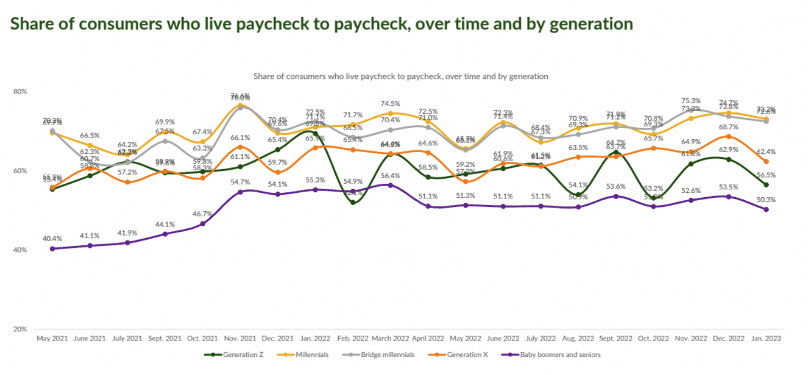Monthly government release reflects what lenders’ recent earnings reports have hinted: millennials are sinking in debt.
The Federal Reserve Bank of New York released its February Survey of Consumer Expectations, and debt delinquency expectations overall are on the decline. The share of consumers expecting to not be able to make minimum debt payments dropped from 12.1% in January to 10.6% in February. While this is good news overall, a deeper look at the numbers change when digging into these expectations by age demographic. For under-40s, which includes most millennials and bridge millennials, delinquency expectations rose to 16.4% in February after dipping to 15.8% the previous month.
The Fed-reported numbers align with PYMNTS’ long-running research on consumers’ financial lifestyles, the Paycheck-to-Paycheck report series, in collaboration with LendingClub. Proprietary research done in preparation for the February “Debt and Credit Deep Dive Edition” demonstrates that the share of millennials and bridge millennials living paycheck-to-paycheck is worryingly high. Gen Z so far seems to have escaped these same financial difficulties, although with an age ceiling currently at 25, many members of this generation may still be living at home.

As consumers take on more debt and figure out how to prioritize bills while credit balances remain on the rise, lenders may need to shift some perspective. Although collections remains the ultimate method to recoup missed bill payments, more graduated payment options could be more beneficial for both repayment rates and customer retention. Under the large “buy now, pay later” umbrella, some lenders such as CareCredit offer interest-free credit for a fixed term for healthcare bills. Other sector players, such as TempoPay, offer a no-interest or fee-free healthcare payment card allowing repayment through options such as payroll deductions, bank account or HSA.
While those two products are specific to healthcare, FinTech Candidly announced a successful round of Series B funding earlier in March. The company’s student debt and savings optimization platform is embedded within digital systems of chosen partners like employers or banks to help users pay down student debt faster.
These innovations are only a few strategies aimed at assisting consumers pay down their debt successfully. Lenders considering their collections strategies may consider these programs and tools to increase the chances of repayment.